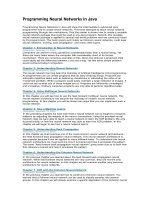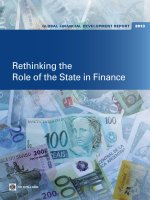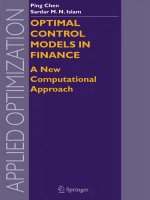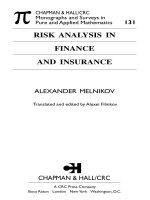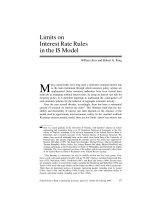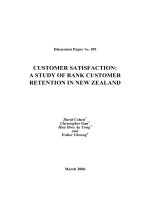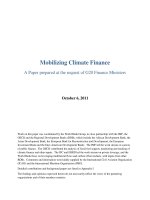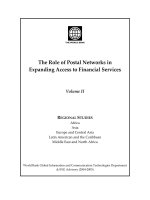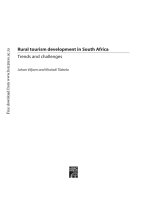Elsevier, Neural Networks In Finance 2005_9 potx
Bạn đang xem bản rút gọn của tài liệu. Xem và tải ngay bản đầy đủ của tài liệu tại đây (503.67 KB, 27 trang )
200 8. Classification: Credit Card Default and Bank Failures
When working with any nonlinear function, however, we should never
underestimate the difficulties of obtaining optima, even with simple probit
or Weibull models used for classification. The logit model, of course, is a
special case of the neural network, since a neural network with one logsig-
moid neuron reduces to the logit model. But the same tools we examined
in previous chapters — particularly hybridization or coupling the genetic
algorithm with quasi-Newton gradient methods — come in very handy.
Classification problems involving nonlinear functions have all of the same
problems as other models, especially when we work with a large number of
variables.
8.1 Credit Card Risk
For examining credit card risk, we make use of a data set used by Baesens,
Setiono, Mues, and Vanthienen (2003), on German credit card default rates.
The data set we use for classification of default/no default for German
credit cards consists of 1000 observations.
8.1.1 The Data
Table 8.1 lists the twenty arguments, a mix of categorical and continuous
variables. Table 8.1 also gives the maximum, minimum, and median values
of each of the variables. The dependent variable y takes on a value of 0 if
there is no default and a value of 1 if there is a default. There are 300 cases
of defaults in this sample, with y = 1. As we can see in the mix of variables,
there is considerable discretion about how to categorize the information.
8.1.2 In-Sample Performance
The in-sample performance of the five methods appears in Table 8.2. This
table pictures both the likelihood functions for the four nonlinear alter-
natives to the discriminant analysis and the error percentages of all five
methods. There are two types of errors, as taught from statistical decision
theory. False positives take place when we incorrectly label the dependent
variables as 1, with y = 1 when y =0. Similarly, false negatives occur when
we have y = 0 when y = 1. The overall error ratio in Table 8.2 is simply a
weighted average of the two error percentages, with the weight set at .5.
In the real world, of course, decision makers attach differing weights to
the two types of errors. A false positive means that a credit agency or bank
incorrectly denies a credit card to a potentially good customer and thus
loses revenue from a reliable transaction. A false negative is more serious:
it means extending credit to a potentially unreliable customer, and thus
the bank assumes much higher default risk.
8.1 Credit Card Risk 201
TABLE 8.1. Attributes for German Credit Data Set
Variable Definition
Type/Explanation
Max Min Median
1 Checking account Categorical, 0 to 3
3 0 1
2 Term Continuous
72 4 18
3 Credit history Categorical, 0 to 4, from no history to delays
4 0 2
4 Purpose Categorical, 0 to 9, based on type of purchase
10 0 2
5 Credit amount Continuous
18424 250 2319.5
6 Savings account Categorical, 0 to 4, lower to higher to unknown
4 0 1
7 Yrs in present employment Categorical, 0 to
4, 1 unemployment, to longer years
4 0 2
8 Installment rate Continuous
4 1 3
9 Personal status and gender Categorical, 0 to
5, 1 male, divorced, 5 female, single
3 0 2
10 Other parties Categorical, 0 to 2, none, 2 co-applicant, 3 guaran
tor 2 0 0
11 Yrs in present residence Continuous
4 1 3
12 Property type Categorical, 0 to 3, 0 real estate, 3 no property or
unknown 3 0 2
13 Age Continuous
75 19 33
14 Other installment plans Categorical, 0 to
2, 0 bank, 1 stores, 2 none
2 0 0
15 Housing status Categorical, 0 to 2, 0 rent, 1 own, 2 for free
2 0 2
16 Number of existing credits Continuous
4 1 1
17 Job status Categorical, 0 to 3, unemployed, 3 management
3 0 2
18 Number of dependents Continuous
2 1 1
19 Telephone Categorical, 0 to 1, 0 none, 1 yes, under customer
name 1 0 0
20 Foreign worker Categorical, 0 to 1, 0 yes, 1 no
1 0 0
202 8. Classification: Credit Card Default and Bank Failures
TABLE 8.2. Error Percentages
Method Likelihood Fn. False False Weighted
Positives Negatives Average
Discriminant analysis na 0.207 0.091 0.149
Neural network 519.8657 0.062 0.197 0.1295
Logit 519.8657 0.062 0.197 0.1295
Probit 519.1029 0.062 0.199 0.1305
Weibull 516.507 0.072 0.189 0.1305
The neural network alternative to the logit, probit, and Weibull meth-
ods is a network with three neurons. In this case, it is quite similar to a
logit model, and in fact the error percentages and likelihood functions are
identical. We see in Table 8.2 a familiar trade-off. Discriminant analysis
has fewer false negatives, but a much higher percentage (by more than a
factor of three) of false positives.
8.1.3 Out-of-Sample Performance
To evaluate the out-of-sample forecasting accuracy of the alternative mod-
els, we used the 0.632 bootstrap method described in Section 4.2.8. To
summarize this method, we simply took 1000 random draws of data from
the original sample, with replacement, to do an estimation, and thus used
the excluded data from the original sample to evaluate the out-of-sample
forecast performance. We measured the out-of-sample forecast performance
by the error percentages of false positives or false negatives. We repeated
this process 100 times and examined the mean and distribution of the
error-percentages of the alternative models.
Table 8.3 gives the mean error percentages for each method, based on the
bootstrap experiments. We see that the neural network and logit models
give identical performance, in terms of out-of-sample accuracy. We also see
that discriminant analysis and the probit and Weibull methods are almost
mirror images of each other. Whereas discriminant analysis is perfectly
accurate in terms of false positives, it is extremely imprecise (with an error
rate of more than 75%) in terms of false negatives, while probit and Weibull
are quite accurate in terms of false negatives, but highly imprecise in terms
of false positives. The better choice would be to use logit or the neural
network method.
The fact that the network model does not outperform the logit model
should not be a major cause for concern. The logit model is a neural net
model with one neuron. The network we use is a model with three neu-
rons. Comparing logit and neural network models is really a comparison
of two alternative neural network specifications, one with one neuron and
8.1 Credit Card Risk 203
TABLE 8.3. Out-of-Sample Forecasting: 100 Draws Mean Error Percentages
(0.632 Bootstarp)
Method False False Weighted
Positives Negatives Average
Discriminant analysis 0.000 0.763 0.382
Neural network 0.095 0.196 0.146
Logit 0.095 0.196 0.146
Probit 0.702 0.003 0.352
Weibull 0.708 0.000 0.354
another with three. What is surprising is that the introduction of the addi-
tional two neurons in the network does not cause a deterioration of the
out-of-sample performance of the model. By adding the two additional
neurons we are not overfitting the data or introducing nuisance param-
eters which cause a decline in the predictive performance of the model.
What the results indicate is that the class of parsimoniously specified neu-
ral network models greatly outperforms discriminant analysis, probit, and
Weibull specifications.
Figure 8.1 pictures the distribution of the weighted average (of false posi-
tives and negatives) for the two models over the 100 bootstrap experiments.
We see that they are identical.
8.1.4 Interpretation of Results
Table 8.4 gives information on the partial derivatives of the models as well
as the corresponding marginal significance or P -values of these estimates,
based on the bootstrap distributions. We see that the estimates of the
network and logit models are for all practical purposes identical. The probit
model results do not differ by much, whereas the Weibull estimates differ
by a bit more, but not by a large factor.
Many studies using classification methods are not interested in the par-
tial derivatives, since interpretation of specific categorical variables is not
as straightforward as continuous variables. However, the bootstrapped
P -values show that credit amount, property type, job status, and number
of dependents are not significant. Some results are consistent with expec-
tations: the greater the number of years in present employment, the lower
the risk of a default. Similarly for age, telephone, other parties, or status
as a foreign worker: older persons, who have telephones in their own name,
have partners in their account, and are not foreign are less likely to default,
We also see that having a higher installment rate or multiple installment
plans is more likely to lead to default.
204 8. Classification: Credit Card Default and Bank Failures
0.125 0.13 0.135 0.14 0.145 0.15 0.155
0
20
40
60
80
0.125 0.13 0.135 0.14 0.145 0.15 0.155
0
20
40
60
80
NETWORK MODEL
LOGIT MODEL
FIGURE 8.1. Distribution of 0.632 bootstrap out-of-sample error percentages
While all three models give broadly consistent interpretations, this
should be reassuring rather than a cause of concern. These results indi-
cate that using two methods, logit and neural net, one as a check on the
other, may be sufficient for both accuracy and understanding.
8.2 Banking Intervention
Banking intervention, the need to close or to put a private bank under
state management, more extensive supervision, or to impose a change of
management, is, unfortunately, common enough both in developing and in
mature industrialized countries. We use the same binary or classification
methods to examine how well key characteristics of banks may serve as
early warning signals for a crisis or intervention of a particular bank.
8.2.1 The Data
Table 8.5 gives information about the dependent variables as well as
explanatory variables we use for our banking study. The data were obtained
8.2 Banking Intervention 205
TABLE 8.4.
Variable Definition Partial Derivatives* Prob Values**
Network Logit Probit Weibull Network Logit Probit Weibull
1 Checking account 0.074 0.074 0.076 0.083 0.000 0.000 0.000 0.000
2 Term 0.004 0.004 0.004 0.004 0.000 0.000 0.000 0.000
3 Credit history −0.078 −0.078 −0.077 −0.076 0.000 0.000 0.000 0.000
4 Propose −0.007 −0.007 −0.007 −0.007 0.000 0.000 0.000 0.000
5 Credit amount 0.000 0.000 0.000 0.000 0.150 0.150 0.152 0.000
6 Savings account −0.008 −0.008 −0.009 −0.010 0.020 0.020 0.020 0.050
7 Yrs in present
employment
−0.032 −0.032 −0.031 −0.030 0.000 0.000 0.000 0.000
8 Installment rate 0.053 0.053 0.053 0.049 0.000 0.000 0.000 0.000
9 Personal status
and gender
−0.052 −0.052 −0.051 −0.047 0.000 0.000 0.000 0.000
10 Other parties −0.029 −0.029 −0.026 −0.020 0.010 0.010 0.020 0.040
11 Yrs in present
residence
0.008 0.008 0.008 0.004 0.050 0.050 0.040 0.060
12 Property type −0.002 −0.002 −0.000 0.003 0.260 0.260 0.263 0.300
13 Age −0.003 −0.003 −0.003 −0.002 0.000 0.000 0.000 0.010
14 Other installment
plans
0.057 0.057 0.062 0.073 0.000 0.000 0.000 0.000
15 Housing status −0.047 −0.047 −0.050 −0.051 0.000 0.000 0.000 0.000
16 Number of
existing credits
0.057 0.057 0.055 0.053 0.000 0.000 0.000 0.000
17 Job status 0.003 0.003 0.006 0.012 0.920 0.920 0.232 0.210
18 Number of
dependents
0.032 0.032 0.030 0.022 0.710 0.710 0.717 0.030
19 Telephone −0.064 −0.064 −0.065 −0.067 0.000 0.000 0.000 0.000
20 Foreign worker −0.165 −0.165 −0.153 −0.135 0.000 0.000 0.000 0.000
*: Derivatives calculated as finite differences
**: Prob values calculated from bootstrap distributions
from the Federal Reserve Bank of Dallas using banking records from the
last two decades. The total percentage of banks that required interven-
tion, either by state or federal authorities, was 16.7. We use 12 variables
as arguments. The capital-asset ratio, of course, is the key component of
the well-known Basel accord for international banking standards.
While the negative number for the minimum of the capital-asset ratio
may seem surprising, the data set includes both sound and unsound banks.
When we remove the observations having negative capital-asset ratios, the
distribution of this variable shows that the ratio is between 5 and 10% for
most of the banks in the sample. The distribution appears in Figure 8.2.
8.2.2 In-Sample Performance
Table 8.6 gives information about the in-sample performance of the
alternative models.
206 8. Classification: Credit Card Default and Bank Failures
TABLE 8.5. Texas Banking Data
Max Min Median
1 Charter 1 0 0
2 Federal Reserve 1 0 1
3 Capital/asset % 30.9 −77.71 7.89
4 Agricultural loan/total loan ratio 0.822371 0 0.013794
5 Consumer loan/total loan ratio 0.982775 0 0.173709
6 Credit card loan/total loan ratio 0.322974 0 0
7 Installment loan/total loan ratio 0.903586 0 0.123526
8 Nonperforming loan/total loan - % 35.99 0 1.91
9 Return on assets - % 10.06 −36.05 0.97
10 Interest margin - % 10.53 −2.27 3.73
11 Liquid assets/total assets - % 96.54 3.55 52.35
12 U.S. total loans/U.S. gdp ratio 2.21 0.99 1.27
Dependent Variables: Bank closing or intervention
No observations: 12,605
% of Interventions/closings: 16.7
0 5 10 15 20 25 30 35
0
1000
2000
3000
4000
5000
6000
7000
8000
FIGURE 8.2. Distribution of capital-asset ratio (%)
8.2 Banking Intervention 207
TABLE 8.6. Error Percentages
Method Likelihood Fn. False False Weighted
Positives Negatives Average
Discriminant analysis na 0.205 0.038 0.122
Neural network 65535 0.032 0.117 0.075
Logit 65535 0.092 0.092 0.092
Probit 4041.349 0.026 0.122 0.074
Weibull 65535 0.040 0.111 0.075
TABLE 8.7. Out-of-Sample Forecasting: 40 Draws Mean Error Percentages
(0.632 Bootstarp)
Method False False Weighted
Positives Negatives Average
Discriminant analysis 0.000 0.802 0.401
Neural network 0.035 0.111 0.073
Logit 0.035 0.089 0.107
Probit 0.829 0.000 0.415
Weibull 0.638 0.041 0.340
Similar to the example with the credit card data, we see that discriminant
analysis gives more false positives than the competing nonlinear methods.
In turn, the nonlinear methods give more false negatives than the linear
discriminant method. For overall performance, the network, probit, and
Weibull methods are about the same, in terms of the weighted average
error score. We can conclude that the network model, specified with three
neurons, performs about as well as the most accurate method, for in-sample
estimation.
8.2.3 Out-of-Sample Performance
Table 8.7 gives the mean error percentages, based on the 0.632 bootstrap
method. The ratios are the averages over 40 draws, by the bootstrap
method. We see that discriminant analysis has a perfect score, zero per-
cent, on false positives, but has a score of over 80% on false negatives. The
overall best performance in this experiment is by the neural network, with
a 7.3% weighted average error score. The logit model is next, with a 10%
weighted average score. As in the previous example the neural network
family outperforms the other methods in terms of out-of-sample accuracy.
208 8. Classification: Credit Card Default and Bank Failures
0.068 0.07 0.072 0.074 0.076 0.078 0.08 0.082
0
2
4
6
8
10
12
0.07 0.08 0.09 0.1 0.11 0.12 0.13
0
5
10
15
NETWORK MODEL
LOGIT MODEL
FIGURE 8.3. Distribution of 0.632 bootstrap: out-of-sample error percentages
Figure 8.3 pictures the distribution of the out-of-sample weighted average
error scores of the network and logit models. While the average of the logit
model is about 10%, we see in this figure that the center of the distribution,
for most of the data, is between 11 and 12%, whereas the corresponding
center for the network model is between 7.2 and 7.3%. The network model’s
performance clearly indicates that it should be the preferred method for
predicting individual banking crises.
8.2.4 Interpretation of Results
Table 8.8 gives the partial derivatives as well as the corresponding P-values
(based on bootstrapped distributions). Unlike the previous example, we do
not have the same broad consistency about the signs or significance of
the key variables. However, what does emerge is the central importance
of the capital asset ratio as an indicator of banking vulnerability. The
higher this ratio, the lower the likelihood of banking fragility. Three of
the four models (network, logit, and probit) indicate that this variable
is significant, and the magnitude of the derivatives (calculated by finite
differences) is the same.
8.3 Conclusion 209
TABLE 8.8.
No. Definition Partial Derivatives* Prob Values**
Network Logit Probit Weibull Network Logit Probit Weibull
1 Charter 0.000 0.000 −0.109 −0.109 0.767 0.833 0.267 0.533
2 Federal Reserve 0.082 0.064 0.031 0.031 0.100 0.167 0.000 0.400
3 Capital/asset % −0.051 −0.036 −0.053 −0.053 0.000 0.000 0.000 0.367
4 Agricultural loan/
total loan ratio
0.257 0.065 −0.020 −0.020 0.133 0.200 0.000 0.600
5 Consumer loan/
total loan ratio
0.397 0.088 0.094 0.094 0.300 0.767 0.000 0.433
6 Credit card loan/
total loan ratio
1.049 −1.163 −0.012 −0.012 0.700 0.233 0.000 0.567
7 Installment loan/
total loan ratio
−0.137 0.187 −0.115 −0.115 0.967 0.233 0.000 0.600
8 Nonperforming
loan/total loan - %
0.004 0.001 0.010 0.010 0.167 0.167 0.067 0.533
9 Return on
assets - %
−0.042 −0.025 −0.032 −0.032 0.067 0.133 0.000 0.367
10 Interest margin - % 0.013 −0.029 0.018 0.018 0.967 0.933 1.000 0.567
11 Liquid assets/
total assets - %
0.001 0.002 0.001 0.001 0.067 0.667 0.000 0.533
12 U.S. total loans/
U.S. gdp ratio
0.149 0.196 0.118 0.118 0.000 0.033 0.000 0.333
*: Derivatives calculated as finite differences
**: Prob values calculated from bootstrap distributions
The same three models also indicate that the aggregate U.S. total loan
to total GDP ratio is also a significant determinant of an individual bank’s
fragility. Thus, both aggregate macro conditions and individual bank char-
acteristics matter, as informative signals for banking problems. Finally, the
network model (as well as the probit) show that return on assets is also
significant as an indicator, with a higher return, as expected, lowering the
likelihood of banking fragility.
8.3 Conclusion
In this chapter we examined two data sets, one on credit card default rates,
and the other on banking failures or fragilities requiring government inter-
vention. We found that neural nets either perform as well as or better than
the best nonlinear alternative, from the set of logit, probit, or Weibull
models, for classification. The hybrid evolutionary genetic algorithm and
classical gradient-descent methods were used to obtain the parameter esti-
mates for all of the nonlinear models. So we were not handicapping one
or another model with a less efficient estimation process. On the contrary,
210 8. Classification: Credit Card Default and Bank Failures
we did the best to find, as closely as possible, the global optima when
maximizing the likelihood functions.
There are clearly many interesting examples to study with this method-
ology. The work on early warning signals for currency crises would be
amenable to this methodology. Similarly, further work comparing neural
networks to standard models can be done on classification problems involv-
ing more than two categories, or on discrete ordered multinomial problems,
such as student evaluation rankings of professors on a scale of one through
five [see Evans and McNelis (2000)].
The methods in this chapter could be extended into more elaborate net-
works in which the predictions of different models, such as discriminant,
logit, probit, and Weibull, are fed in as inputs to a complex neural net-
work. Similarly, forecasting can be done in a thick modeling or bagging
approach: all of the models can be used, and a mean or trimmed mean can
be the forecast from a wide set of models, including a variety of neural nets
specified with different numbers of neurons in the hidden layer. But in this
chapter we wanted to keep the “race” simple, so we leave the development
of more elaborate networks for further exploration.
8.3.1 MATLAB Program Notes
The programs for these two country experiences are germandefault prog.m
for German credit card default rates, and texasfinance
prog.m for the
Texas bank failures. The data are given in germandefault
run4.mat and
texasfinance
run9.mat.
8.3.2 Suggested Exercises
An interesting sensitivity analysis would be to reduce the number of
explanatory variables used in this chapter’s examples to smaller sets of
regressors to see if the same variables remain significant in the modified
models.
9
Dimensionality Reduction and Implied
Volatility Forecasting
In this chapter we apply the methodologies of linear and nonlinear principal
component dimensionality reduction to observed volatilities on Hong Kong
and United States swap options of differing maturities, of one to ten years,
to see if these methods help us to find the underlying volatility signal from
the market. The methods are presented in Section 2.6.
Obtaining an accurate measure of the market volatility, when in fact
there are many different market volatility measures or alternative nonmar-
ket measures of volatility to choose from, is a major task for effective option
pricing and related hedging activities. A major focus in financial market
research today is volatility, rather than return, forecasting. Volatilities, as
proxies of risk, are asymmetric and perhaps nonlinear processes, at the very
least, to the extent that they are bounded by zero from below. So nonlinear
approximation methods such as neural networks may have a payoff when
we examine such processes.
We compare and contrast the implied volatility measures for Hong Kong
and the United States, since we expect both of these to have similar fea-
tures, due to the currency peg of the Hong Kong dollar to the U.S. dollar.
But there may also be some differences, since Hong Kong was more vul-
nerable to the Asian financial crisis which began in 1997, and also had
the SARS crisis in 2003. We discuss both of these experiences in turn,
and apply the linear and nonlinear dimensionality reduction methods for
in-sample as well as for out-of-sample performance.
212 9. Dimensionality Reduction and Implied Volatility Forecasting
1997 1998 1999 2000 2001 2002 2003 2004
10
20
30
40
50
60
70
FIGURE 9.1. Hong Kong implied volatility measures, maturity 2, 3, 4, 5, 7,
10 years
9.1 Hong Kong
9.1.1 The Data
The implied volatility measures, for daily data from January 1997 till July
2003, obtained from Reuters, appear in Figure 9.1. We see the sharp
upturn in the measures with the onset of the Asian crisis in late 1997.
There are two other spikes: one around the third quarter of 2001, and
another after the start of 2002. Both of these jumps, no doubt, reflect
uncertainty in the world economy in the wake of the September 11 terrorist
attacks and the start of the war in Afghanistan. The continuing volatility
in 2003 may also be explained by the SARS epidemic in Hong Kong and
East Asia.
Table 9.1 gives a statistical summary of the data appearing in Figure 9.1.
There are a number of interesting features coming from this summary. One
is that both the mean of the implied volatilities, as well as the standard
9.1 Hong Kong 213
TABLE 9.1. Hong Kong Implied Volatility Estimates; Daily Data: Jan. 1997–
July 2003
Statistic Maturity in Years
2345710
Mean 28.581 26.192 24.286 22.951 21.295 19.936
Median 27.500 25.000 23.500 22.300 21.000 20.000
Std. Dev. 12.906 10.183 8.123 6.719 5.238 4.303
Coeff. Var 0.4516 0.3888 0.33448 0.2927 0.246 0.216
Skewness 0.487 0.590 0.582 0.536 0.404 0.584
Kurtosis 2.064 2.235 2.302 2.242 2.338 3.553
Max 60.500 53.300 47.250 47.500 47.500 47.500
Min 11.000 12.000 12.250 12.750 12.000 11.000
deviation of the implied volatility measures, or volatility of the volatilities,
decline as the maturity increases. Related to this feature is that the range,
or difference between maximum and minimum values, is greatest for the
short maturity of two years. The extent of the variability decline in the
data can best be captured by the coefficient of variation, defined as the
ratio of the standard deviation to the mean. We see that this measure
declines by more than 50% as we move from two-year to ten-year maturities.
Finally, there is no excess kurtosis in these measures, whereas rates of
return typically have this property.
9.1.2 In-Sample Performance
Figure 9.2 pictures the evolution of the two principal component measures.
The solid curve comes from the linear method. The broken curve comes
from an auto-associative map or neural network. We estimate the network
with five encoding neurons and five decoding neurons. For ease of compar-
ison, we scaled each series between zero and one. What is most interesting
about Figure 9.2 is how similar both curves are. The linear principal com-
ponent shows a big spike in mid-1999, but the overall volatility of the
nonlinear principal component is slightly greater. The standard deviations
of the linear and nonlinear components are, respectively, .233 and .272,
where their respective coefficients of variation are .674 and .724.
How well do these components explain the variation of the data, for the
full sample? Table 9.2 gives simple goodness-of-fit R
2
measures for each of
the maturities. We see that the nonlinear principal component better fits
the more volatile 2-year maturity, whereas the linear component fits much,
much better at 5, 7, and 10-year maturities.
214 9. Dimensionality Reduction and Implied Volatility Forecasting
1997 1998 1999 2000 2001 2002 2003 2004
0
0.1
0.2
0.3
0.4
0.5
0.6
0.7
0.8
0.9
1
Linear
Principal
Component
Nonlinear
Principal
Component
FIGURE 9.2. Hong Kong linear and nonlinear principal component measures
TABLE 9.2. Hong Kong Implied Volatility Estimates Goodness of Fit: Linear
and Nonlinear Components, Multiple Correlation Coefficient
Maturity in Years
2345710
Linear 0.965 0.986 0.990 0.981 0.923 0.751
Nonlinear 0.988 0.978 0.947 0.913 0.829 0.698
9.1.3 Out-of-Sample Performance
To evaluate the out-of-sample performance of each of the models, we did
a recursive estimation of the principal components. First, we took the
first 80% of the data, estimated the principal component coefficients and
nonlinear functions for extracting one component, brought in the next
observation, and applied these coefficients and functions for estimating the
new principal component. We used this new forecast principal component
9.1 Hong Kong 215
2002.2 2002.4 2002.6 2002.8 2003 2003.2 2003.4 2003.6 2003.8
2002.2 2002.4 2002.6 2002.8 2003 2003.2 2003.4 2003.6 2003.8
−15
−10
−5
0
5
10
15
−10
−5
0
5
10
15
Linear Principal Component
Nonlinear Principal Component
FIGURE 9.3. Hong Kong recursive out-of-sample principal component prediction
errors
to explain the six observed volatilities at that observation. We then con-
tinued this process, adding in one observation each period, updating the
sample, and re-estimating the coefficients and nonlinear functions, until
the end of the data set.
The forecast errors of the recursively updated principal components
appear in Figure 9.3. It is clear that the errors of the nonlinear princi-
pal component forecasting model are generally smaller than those of the
linear principal component model. The most noticeable jump in the non-
linear forecast errors takes place in early 2003, at the time of the SARS
epidemic in Hong Kong.
Are the forecast errors significantly different from each other? Table 9.3
gives the root mean squared error statistics as well as Diebold-Mariano tests
of significance for these forecast errors, for each of the volatility measures.
The results show that the nonlinear principal components do significantly
better than the linear principal components at maturities of 2, 3, 7, and
10 years.
216 9. Dimensionality Reduction and Implied Volatility Forecasting
TABLE 9.3. Hong Kong Implied Volatility Estimates: Out-of-Sample Prediction
Performance, Root Mean Squared Error
Maturity in Years
2345710
Linear 4.195 2.384 1.270 2.111 4.860 7.309
Nonlinear 1.873 1.986 2.598 2.479 1.718 1.636
Diebold-Mariano Tests
∗
Maturity in Years
2345710
DM-0 0.000 0.000 1.000 0.762 0.000 0.000
DM-1 0.000 0.000 1.000 0.717 0.000 0.000
DM-2 0.000 0.000 1.000 0.694 0.000 0.000
DM-3 0.000 0.000 1.000 0.678 0.000 0.000
DM-4 0.000 0.000 1.000 0.666 0.000 0.000
Note:
∗
P-values
DM-0 to DM-4: tests at autocorrelations 0 to 4.
9.2 United States
9.2.1 The Data
Figure 9.4 pictures the implied volatility measures for the same time period
as the Hong Kong data, for the same maturities. While the general pattern
is similar, we see that there is less volatility in the volatility measures in
1997 and 1998. There is a spike in the data in late 1998. The jump in
volatility in later 2001 is of course related to the September 11 terrorist
attacks, and the further increased volatility beginning in 2002 is related to
the start of hostilities in the Gulf region and Afghanistan.
The statistical summary of these data appear in Table 9.4. The overall
volatility indices of the volatilities, measured by the standard deviations
and the coefficients of variation, are actually somewhat higher for the
United States than for Hong Kong. But otherwise, we observe the same
general properties that we see in the Hong Kong data set.
9.2.2 In-Sample Performance
Figure 9.5 pictures the linear and nonlinear principal components for the
U.S. data. As in the case of Hong Kong, the volatility of the nonlinear
principal component is greater than that of the linear principal component.
9.2 United States 217
1997 1998 1999 2000 2001 2002 2003 2004
10
20
30
40
50
60
70
FIGURE 9.4. U.S. implied volatility measures, maturities 2, 3, 4, 5, 7, 10 years
TABLE 9.4. U.S. Implied Volatility Estimates, Daily Data: Jan. 1997–July 2003
Statistic Maturity in Years
2345710
Mean 24.746 23.864 22.799 21.866 20.360 18.891
Median 17.870 18.500 18.900 19.000 18.500 17.600
Std. Dev. 14.621 11.925 9.758 8.137 6.106 4.506
Coeff. Var 0.591 0.500 0.428 0.372 0.300 0.239
Skewness 1.122 1.214 1.223 1.191 1.092 0.952
Kurtosis 2.867 3.114 3.186 3.156 3.023 2.831
Max 66.000 59.000 50.000 44.300 37.200 31.700
Min 10.600 12.000 12.500 12.875 12.750 12.600
218 9. Dimensionality Reduction and Implied Volatility Forecasting
1997 1998 1999 2000 2001 2002 2003 2004
0
0.1
0.2
0.3
0.4
0.5
0.6
0.7
0.8
0.9
1
Nonlinear
Principal
Component
Linear
Principal
Component
FIGURE 9.5. U.S. linear and nonlinear principal component measures
TABLE 9.5. U.S. Implied Volatility Estimates Goodness of Fit: Linear and
Nonlinear Components Multiple Correlation Coefficient
Maturity in Years
2345710
Linear 0.983 0.995 0.997 0.998 0.994 0.978
Nonlinear 0.995 0.989 0.984 0.982 0.977 0.969
The goodness-of-fit R
2
measures appear in Table 9.5. We see that there
is not as great a drop-off in the explanatory power of the two components,
as in the case of Hong Kong, as we move up the maturity scale.
9.2.3 Out-of-Sample Performance
The recursively estimated out-of-sample prediction errors of the two com-
ponents appear in Figure 9.6. As in the case of Hong Kong, the prediction
errors of the nonlinear component appear to be more tightly clustered.
9.3 Conclusion 219
2002.2 2002.4 2002.6 2002.8 2003 2003.2 2003.4 2003.6 2003.8
2002.2 2002.4 2002.6 2002.8 2003 2003.2 2003.4 2003.6 2003.8
−15
−10
−5
0
5
10
15
−10
−5
0
5
10
15
Linear Principle Component
Nonlinear Principle Component
FIGURE 9.6. U.S. recursive out-of-sample principal component prediction errors
There are noticeable jumps in the nonlinear prediction errors in mid-2002
and in 2003 at the end of the sample.
The root mean squared error statistics as well as the Diebold-Mariano
tests of significance appear in Table 9.5. For the United States, the nonlin-
ear component outperforms the linear component for all maturities except
for four years.
1
9.3 Conclusion
In this chapter we examined the practical uses of linear and nonlinear com-
ponents for analyzing volatility measures in financial markets, particularly
the swap option market. We see that the principal component extracts by
1
For the three-year maturity the linear root mean squared error is slightly lower than
the error of the nonlinear component. However, the slightly higher linear statistic is due
to a few jumps in the nonlinear error. Otherwise, the nonlinear error remains much closer
to zero. This explains the divergent results of the squared error and Diebold-Mariano
statistics.
220 9. Dimensionality Reduction and Implied Volatility Forecasting
TABLE 9.5. U.S. Implied Volatility Estimates: Out-of-Sample Prediction Per-
formance Root Mean Squared Error
Maturity in Years
2345710
Linear 5.761 2.247 1.585 3.365 5.843 7.699
Nonlinear 1.575 2.249 2.423 2.103 1.504 1.207
Diebold-Mariano Tests
∗
Maturity in Years
2345710
DM-0 0.000 0.000 0.997 0.000 0.000 0.000
DM-1 0.000 0.002 0.986 0.000 0.000 0.000
DM-2 0.000 0.006 0.971 0.000 0.000 0.000
DM-3 0.000 0.011 0.956 0.000 0.000 0.000
DM-4 0.000 0.017 0.941 0.001 0.000 0.000
Note:
∗
P-values
DM-0 to DM-4: tests at autocorrelations 0 to 4.
the nonlinear auto-associative mapping are much more effective for out-of-
sample predictions than the linear component. However, both components,
for both countries, follow broadly similar patterns. Doing a simple test of
causality, we find that both the U.S. components, whether linear or non-
linear, can help predict the linear or nonlinear Hong Kong components,
but not vice-versa. This should not be surprising, since the U.S. market is
much larger and many of the pricing decisions would be expected to follow
U.S. market developments.
9.3.1 MATLAB Program Notes
The main MATLAB program for this chapter is neftci capfloor prog.m. The
final output and data are in USHKCAPFLOOR
ALL run77.mat.
9.3.2 Suggested Exercises
An interesting extension would be to find one principal component for the
combined set of U.S. and Hong Kong cap-floor volatilities. Following this,
the reader could compare the one principal component for the combined
set with the corresponding principal component for each country. Are there
any differences?
Bibliography
Aarts, E., and J. Korst (1989), Simulated Annealing and Boltzmann
Machines: A Stochastic Approach to Combinatorial Optimization and
Neural Computing. New York: John Wiley and Sons.
Akaike, H. (1974), “A New Look At Statistical Model Identification,” IEEE
Transactions on Automatic Control, AC-19, 46: 716–723.
Altman, Edward (1981), Applications of Classification Procedures in
Business, Banking and Finance. Greenwich, CT: JAI Press.
Arifovic, Jasmina (1996), “The Behavior of the Exchange Rate in the
Genetic Algorithm and Experimental Economies,” Journal of Political
Economy 104: 510–541.
B¨ack, T. (1996), Evolutionary Algorithms in Theory and Practice. Oxford:
Oxford University Press.
Baesens, Bart, Rudy Setiono, Christophe Mues, and Jan Vanthienen
(2003), “Using Neural Network Rule Extraction and Decision Tables
for Credit-Risk Evaluation.” Management Science 49: 312–329.
Banerjee, A, R.L. Lumsdaine, and J. H. Stock (1992), “Recursive and
Sequential Tests of the Unit Root and Trend-Break Hypothesis:
Theory and International Evidence,” Journal of Business and
Economic Statistics 10: 271–287.
222 Bibliography
Bates, David S. (1996), “Jumps and Stochastic Volatility: Exchange Rate
Processes Implicit in Deutsche Mark Options,” Review of Financial
Studies 9: 69–107.
Beck, Margaret (1981), “The Effects of Seasonal Adjustment in Economet-
ric Models.” Discussion Paper 8101, Reserve Bank of Australia.
Bellman, R. (1961), Adaptive Control Processes: A Guided Tour. Princeton,
NJ: Princeton University Press.
Beltratti, Andrea, Serio Margarita, and Pietro Terna (1996), Neural Net-
works for Economic and Financial Modelling. Boston: International
Thomson Computer Press.
Beresteanu, Ariel (2003), “Nonparametric Estimation of Regression
Functions under Restrictions on Partial Derivatives.” Working
Paper, Department of Economics, Duke University. Webpage:
www.econ.duke.edu/˜arie/shape.pdf.
Bernstein, Peter L. (1998), Against the Gods: The Remarkable Story of
Risk. New York: John Wiley and Sons.
Black, Fisher, and Myron Sholes (1973), “The Pricing of Options and
Corporate Liabilities,” Journal of Political Economy 81: 637–654.
Bollerslev, Timothy (1986), “Generalized Autoregressive Conditional
Heteroskedasticity,” Journal of Econometrics, 31: 307–327.
——— (1987), “A Conditionally Heteroskedastic Time Series Model for
Speculative Prices and Rates of Return,” Review of Economics and
Statistics 69: 542–547.
Breiman, Leo (1996), “Bagging Predictors,” Machine Learning 24:
123–140.
Brock, W., W. Deckert, and J. Scheinkman (1987), “A Test for Inde-
pendence Based on the Correlation Dimension,” Working Paper,
Department of Economics, University of Wisconsin at Madison.
———, and B. LeBaron (1996), “A Test for Independence Based on the
Correlation Dimension.” Econometric Reviews 15: 197–235.
Buiter, Willem, and Nikolaos Panigirtazoglou (1999), “Liquidity Traps:
How to Avoid Them and How to Escape Them.” Webpage:
www.cepr.org/pubs/dps/DP2203.dsp.
Bibliography 223
Campbell, John Y., Andrew W. Lo, and A. Craig MacKinlay (1997),
The Econometrics of Financial Markets. Princeton, NJ: Princeton
University Press.
Carreira-Perpinan, M.A. (2001), Continuous Latent Variable Models for
Dimensionality Reduction. University of Sheffield, UK: Ph.D. Thesis.
Webpage: www.cs.toronto.edu/˜miguel/papers.html.
Chen, Xiaohong, Jeffery Racine, and Norman R. Swanson (2001), “Semi-
parametric ARX Neural Network Models with an Application to
Forecasting Inflation,” IEEE Transactions in Neural Networks 12:
674–683.
Chow, Gregory (1960), “Statistical Demand Functions for Automobiles and
Their Use for Forecasting,” in Arnold Harberger (ed.), The Demand
for Durable Goods. Chicago: University of Chicago Press, 149–178.
Clark, Todd E., and Michael W. McCracken (2001), “Tests of Fore-
cast Accuracy and Encompassing for Nested Models,” Journal of
Econometrics 105: 85–110.
Clark, Todd E., and Kenneth D. West (2004), “Using Out-of-Sample Mean
Squared Prediction Errors to Test the Martingale Difference Hypoth-
esis.” Madison, WI: Working Paper, Department of Economics,
University of Wisconsin.
Clouse, James, Dale Henderson, Athanasios Orphanides, David Small,
and Peter Tinsley (2003), “Monetary Policy when the Nominal Short
Term Interest Rate is Zero,” in Topics in Macroeconomics. Berkeley
Electronic Press: www.bepress.com.
Collin-Dufresne, Pierre, Robert Goldstein, and J. Spencer Martin (2000),
“The Determinants of Credit Spread Changes.” Working Paper, Grad-
uate School of Industrial Administration, Carnegie Mellon University.
Cook, Steven (2001), “Asymmetric Unit Root Tests in the Presence of
Structural Breaks Under the Null,” Economics Bulletin: 1–10.
Corradi, Valentina, and Norman R. Swanson (2002), “Some Recent Devel-
opments in Predictive Accuracy Testing with Nested and (Generic)
Nonlinear Alternatives.” New Brunswick, NJ: Working Paper, Depart-
ment of Economics, Rutgers University.
Craine, Roger, Lars A. Lochester, and Knut Syrtveit (1999), “Estima-
tion of a Stochastic-Volatility Jump Diffusion Model.” Unpublished
224 Bibliography
Manuscript, Department of Economics, University of California,
Berkeley.
Dayhoff, Judith E., and James M. DeLeo (2001), “Artificial Neural
Networks: Opening the Black Box.” Cancer 91: 1615–1635.
De Falco, Ivanoe (1998), “Nonlinear System Identification by Means
of Evolutionarily Optimized Neural Networks,” in Quagliarella, D.,
J. Periaux, C. Poloni, and G. Winter (eds.), Genetic Algorithms
and Evolution Strategy in Engineering and Computer Science: Recent
Advances and Industrial Applications. West Sussex, England: John
Wiley and Sons.
Dickey, D.A., and W.A. Fuller (1979), “Distribution of the Estimators
for Autoregressive Time Series With a Unit Root,” Journal of the
American Statistical Association 74: 427–431.
Diebold, Francis X., and Roberto Mariano (1995), “Comparing Predictive
Accuracy,” Journal of Business and Economic Statistics, 3: 253–263.
Engle, Robert (1982), “Autoregressive Conditional Heterskedasticity with
Estimates of the Variance of United Kingdom Inflation,” Econometrica
50: 987–1007.
———, and Victor Ng (1993), “Measuring the Impact of News on
Volatility,” Journal of Finance 48: 1749–1778.
Essenreiter, Robert (1996), Geophysical Deconvolution and Inversion with
Neural Networks. Department of Geophysics, University of Karlsruhe,
www-gpi.physik.uni-karlsruhe.de.
Evans, Martin D., and Paul D. McNelis (2000), “Student Evaluations and
the Assessment of Teaching Effectiveness: What Can We Learn from
the Data.” Webpage: www.georgetown.edu/faculty/mcnelisp/Evans-
McNelis.pdf.
Fotheringhame, David, and Roland Baddeley (1997), “Nonlinear Principal
Components Analysis of Neuronal Spike Tran Data.” Working Paper,
Department of Physiology, University of Oxford.
Franses, Philip Hans, and Dick van Dijk (2000), Non-linear Time Series
Models in Empirical Finance. Cambridge, UK: Cambridge University
Press.
Gallant, A. Ronald, Peter E. Rossi, and George Tauchen (1992), “Stock
Prices and Volume.” Review of Financial Studies 5: 199–242.
